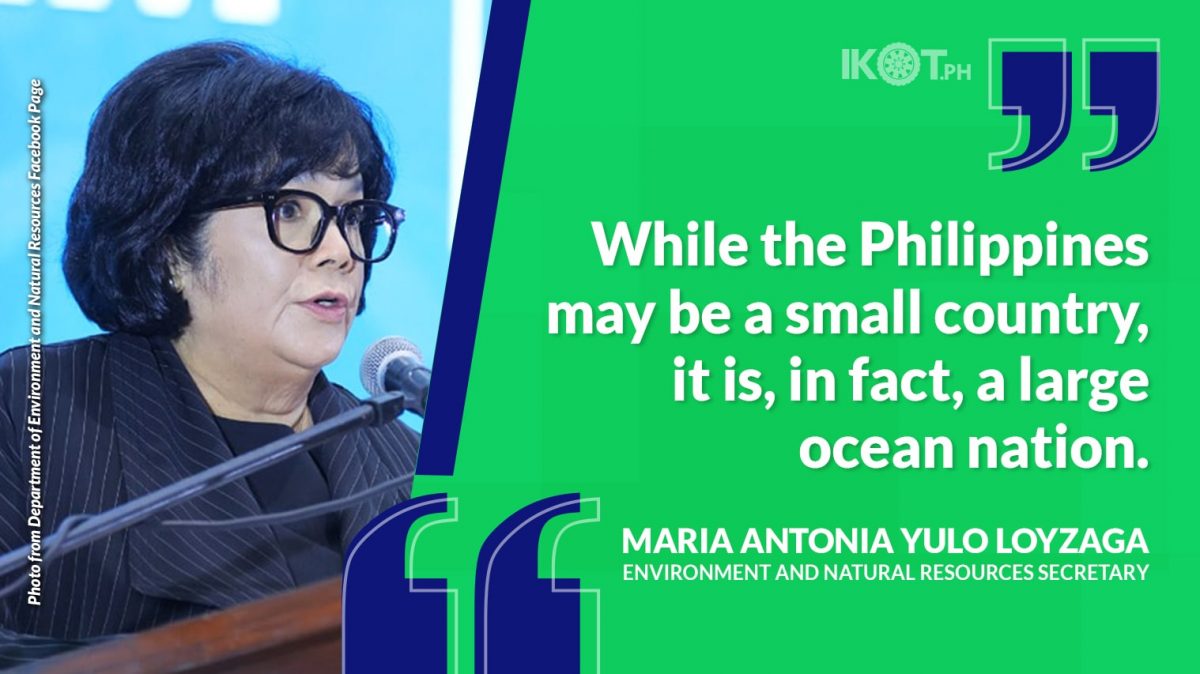Distinguished oceanographer, National Geographic Explorer in Residence and Mission Blue Founder Dr. Sylvia Earle recently met with the Department of Environment and Natural Resources (DENR) and partners for the conservation of the Verde Island Passage (VIP) to discuss marine life preservation and experience firsthand diving in what is known as the “center of the world’s marine shore fish biodiversity”.
Earle’s first visit to the Philippines is upon the invitation of DENR Secretary Maria Antonia Yulo Loyzaga and coincides with the country’s observance of June as the Philippine Environment Month.
Meeting “Her Deepness”, as Earle is called, is considered a momentous occasion especially by the country’s marine scientists and advocates for the protection and conservation of the Philippines rich coastal and marine ecosystems.
This is especially in light of new threats to biodiversity in the high seas and to the deep-sea environments.
The first woman to lead the National Oceanographic and Atmospheric Administration (NOAA) of the United States, Earle noted that nature had changed at a rate that is essentially geological in terms of its speed, but this is no longer the case “because of the actions of one species – that would be us.”
She stressed that humans are “at a point in time when what we do or what we fail to do will determine what the next 50 or 500 or 5,000 years will be”.
In a dialogue with the conservation partners, the respected oceanographer discussed the importance of integrating biodiversity conservation with climate action, and the indispensable role of the ocean in achieving global climate goals. She also emphasized that one cannot care for the ocean if one does not know it. Given this, Earle pointed out that there have never been tools and technologies to build that knowledge, but never before has man’s power to alter nature been greater.
The meeting included United States Ambassador to the Philippines MaryKay Carlson, environmental champion Senator Loren Legarda, representatives from the University of the Philippines Marine Science Institute and De Lasalle University, NGOs such as ABS-CBN Foundation, Conservation International Philippines, and Communities Organized for Resource Allocation (CORA). They were joined by major private sector stakeholders in the conservation of VIP including Aboitiz Equity Ventures (AEV), Metro Pacific Investments Corporation (MPIC), San Miguel Corporation (SMC), First Gen Corporation (FGC) and the Ten Knots Group.
Earle described the VIP as a unique global treasure, emphasizing its profound historical significance and exceptional biodiversity. She stressed the honor and respect befitting the area, attesting to its rich biodiversity as the “center of the world’s marine shore fish biodiversity” while highlighting the urgent need for proactive conservation efforts amid growing threats.
“We need to come together to take care of nature, take care of the ocean, as if our lives depend on it, because they do.”
“Whether it’s industry, education, science, government, whatever the powers that are represented, we need to come together to take care of nature, take care of the ocean, as if our lives depend on it, because they do,” she added.
Earle’s discussion was supplemented by Loyzaga, who underscored the indispensable role of the ocean in achieving global climate goals and advocated for science-based and equitable measures such as the creation of marine protected areas.
She also stressed that while the Philippines may be a small country, it is, in fact, a large ocean nation.
The environment chief also cited the challenges besetting the VIP and the current initiatives for the area, including research studies for its protection and management, and the establishment of marine scientific research stations in collaboration with stakeholders.
“We must move steadfastly in pursuit of a true identity of the VIP and our own country as a resilient and blue nation.”
“With the VIP Protected Seascape Bill on file in the Senate and active collaboration with all stakeholders embracing a whole-of-society approach, we must move steadfastly in pursuit of a true identity of the VIP and our own country as a resilient and blue nation,” the environment head said.
Diving in the Verde Island Passage (VIP)
Earle, along with Mission Blue Global Ocean Policy Advisor Maximiliano Bello, later proceeded to Mabini, Batangas for a dive at the VIP. They were accompanied by the DENR dive team and other Filipino divers and marine scientists and experts including, UP MSI Executive Director Dr. Laura David and DLSU professor Dr. Al Licuanan.
Mission Blue, a global coalition dedicated to ocean conservation, aims to catalyze action and foster partnerships for marine protected areas such as the VIP. In July 2023, Mission Blue named the VIP as a “Hope Spot” in recognition of its critical role in the health of the oceans.
Under the Marcos administration, the DENR is actively seeking to expand research and monitoring to conserve and protect Philippine marine biodiversity. It received congressional funding for six new marine scientific stations in the different biogeographic areas of the country. Most recently, it has partnered with the Department of Energy to support the country’s energy transition while protecting the marine and coastal environment in the VIP along with AEV, MPIC, SMC, and FGC in the establishment of a Passage-wide protection and conservation program and a marine scientific station within the VIP.
The Verde Island Passage is a strait located in the Southern part of Luzon Island and bordered by Batangas, Marinduque, Romblon, and Oriental and Occidental Mindoro provinces. Known to house over sixty percent of known shore fish species, 338 coral species (eight of which are considered rare), several endangered and threatened, and thousands of other marine organisms, it is imperative to place the VIP under stringent protection and conservation measures to enhance and preserve its true value for future generations.
The VIP is also renowned for its mangrove forests and seagrass beds, which are part of blue carbon ecosystems, contributing about ten percent of the Philippines’ national carbon stock. Beyond its rich biodiversity, the VIP supports fishing communities, economic activities, including passenger and goods transport, as well as critical industrial applications such as energy and telecommunications.


